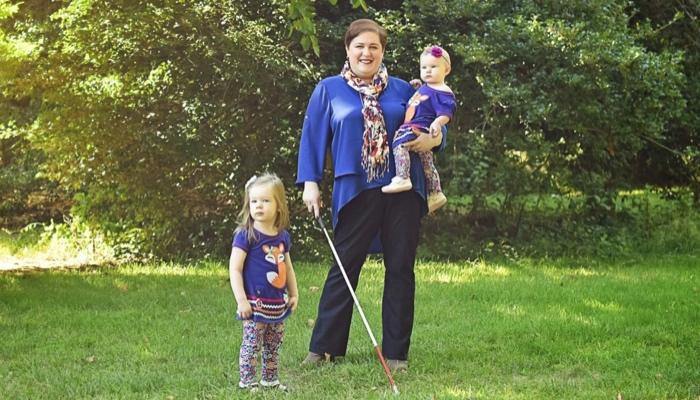Sometimes I just don’t feel like “teaching” people about blindness

This post may contain affiliate links; please see our terms of use for details.
Unlike most women, I absolutely hate shopping. Seriously, with a passion. The idea of going into a store to buy clothes is about appealing to me as going to the dentist. Unfortunately, being an adult means you sometimes have to dress like one. Uggh, I hate that rule. With an important meeting coming up for my day job, I was forced to hit the mall on the quest for a professional ensemble that didn’t include yoga pants.
Since I’m legally blind; I don’t drive. Traveling anywhere usually requires having my husband chauffeur me around with my two toddlers in tow. Doing anything with a double stroller is already complicated. Add in one diaper bag, 2 sippy cups, my pocketbook and an extendable white cane and let’s just say every shopping trip becomes a juggling act.
We left our house immediately after breakfast. Once at the mall, we hit a few of the kid’s favorite stores first. A little parental bribery never hurt anyone, right?
When my daughters appeared to be getting tired, my husband gave me the green light to sneak off alone to get my shopping accomplished.
He didn’t have to tell me twice. I grabbed my purse and hauled ass to the opposite end of the mall. I was moving my cane so quickly across the tiled floor, that you would have thought I was in my very own blind relay race. As much as I hate shopping, I was really looking forward to twenty minutes of toddler-free solitude.
When I reached the front the store, I knew exactly where I was. I folded up my cane and removed my color identifier and ear piece from my purse. As someone who has no color vision at all, the little I can see is always in black and white. Color identifiers help blind people like myself identify colors and their intensity. They can say things like “blue”, “light blue”, or “very dark blue.” Most machines come with an ear piece that is connected by a singular long wire, similar to the earbuds you would use to listen to music. By pairing the color identifier with a hand held magnifier, I’m able to know the color and size of the item I’m looking at.
Don’t get me wrong, I know I could easily ask a sales person to help me in any store. In my experience, very few store employees will turn down the opportunity to assist a visually impaired customer. However, I’ve also found some of these people can become a little too pushy. I mean, just because I am blind doesn’t mean I don’t have an opinion on what I put on my body. For whatever reason, the sales people I’ve encountered always want to put me in the brightest fabrics possible. I am a 36-year-old mother of two. Just because I can’t see, there is no need to make me look like Rainbow Brite!
That being said, I also like the “normalcy factor” I get by shopping independently. I’m quite happy to roam the racks with my ear piece, allowing my color identifier to do the work for me. Unfortunately, it quickly became apparent that this particular shopping excursion would be anything but “normal.”
I noticed an older sales woman following me around the store. She asked if she could hold my items for me. I told her “thank you, but no” and kept on moving. I wasn’t trying to be rude to this lady, but in my mommy mind I was thinking, “hurry the hell up and find something, because you know your husband is going to call you any second.”
I finally grabbed a few possibilities and went into the dressing room to try them on. I was so excited because I was actually able to go down a pant size since the last time I bought a pair of non-yoga pants. As I exited the dressing room, a man was watching me. I assumed he was waiting for his wife or girlfriend. I went back to the racks to look for a different shirt, relying on my color reader yet again, the ear piece still connected.
The same salesperson came up from behind, tapping me on my shoulder. “What are you doing? You can’t use that thing! What is that? Let me see.” She then attempted to grab the color identifier from my hand.
I could feel my ears getting hot. Partly because she was yelling at me and partly because I was embarrassed. In that moment, my desire for normalcy went out the window and I had to make a choice. Should I just snap back at the woman or do I take the opportunity to create a teachable moment for her?
I turned in her direction, doing my best to look her in the eye. “Excuse me. I am a legally blind customer and I assure you, I most certainly can use this thing!”
Now she was the one suffering from embarrassment. Instantly, her entire demeanor changed and she sheepishly said, “Oh, I am sorry, you don’t look blind and I didn’t know what that thing was.”
I pulled the earpiece of out of my ear. “This is called a color identifier. I am completely color blind and have very little vision in one eye. I use this machine to tell me the colors of the clothes and the earpiece allows me to shop discreetly. Well, it usually does.”
She had no words, just nodded and walked away. There were no apologies. No show of interest for what the machine actually did. The conversation was over and as she turned her back to me. It was then I watched her wave to the man whom I thought had also been watching me. He was actually a plain clothes store security guard. It appeared they both had wrongly assumed that I was trying to steal something.
As a blind woman and mom, I constantly battle my desire for a “normalcy factor” versus the need to provide “teachable moments.” It would be great for me to be able to walk into a store, use my cane, magnifier or color reader without anyone giving me a second glance. Sometimes that does happen.
However, there are other times, as in this case, where things can go horribly awry. I end up feeling ashamed, confronted, and singled-out. I feel forced to defend myself and it totally sucks! Advocating for yourself is exhausting. Explaining why you use certain technology or mobility aids gets old.
As a blind mom, I strive to give my girls a sense of normalcy, even when mommy has to use a machine to tell her the color of the shirt she wants to buy. I miss the days when I was fully sighted and the “normalcy factor” was so easily attainable for me. But experiences like these have become my “new normal.”
I accomplished what I had set out to do that morning. I got the clothing I needed and had a nice, chaotic day with my husband and two toddlers. I followed up my visit to the store with a letter to their general management, explaining what happened in detail. I am hopeful that they will address the situation and embrace a “teachable moment” for their staff.
If you’re a visually impaired person, I urge you to never let anyone or anything prevent you from using what you need in order to accomplish any task. If you’re the parent of a blind or visually impaired child, try to find a balance between being your child’s voice and teaching them to use their own. If we all work together to create a new “normalcy factor” for the blind and visually impaired, then teachable moments such as these will be few and far between.
Holly Bonner is a Staten Island based psychotherapist and Director of Education & Outreach for IlluminArt Productions. A wife and mother of two daughters, Holly became legally blind in 2012 after battling breast cancer. She navigates motherhood relying on help from modern technology, a white cane, and her sixth sense provided by eyes in the back of her head! Her website, blindmotherhood.com, chronicles her adventures in parenting and provides useful information for all mommies. Holly lives by the mantra that even without vision, you should never lose sight of life, love and laughter. Her blog is an excellent read, especially if you love the Walking Dead… but even if you don’t!

Related Posts

Visual Impairment
The Gift of Understanding: How a Young Child Helps His Blind Father Navigate Life
When a parent is blind, it’s natural for people to wonder how their sighted child will adapt. Will they struggle to understand their parent’s needs? Will they feel burdened by...

Braille and Literacy, Toys, Visual Impairment
24 Braille Toys for Kids Who are Blind
Everything from alphabet blocks to raised line coloring pages and activity books to puzzles to card and board games... and so much more! And it's all in braille ready for...

Tactile Arts and Crafts, Visual Impairment
Using Origami to Teach Blind and Low-Vision Students Basic Shapes
If, like me, you have wondered why it is important for young students to learn about shapes, here are just a few reasons. Teaching shapes in early education provides children...

